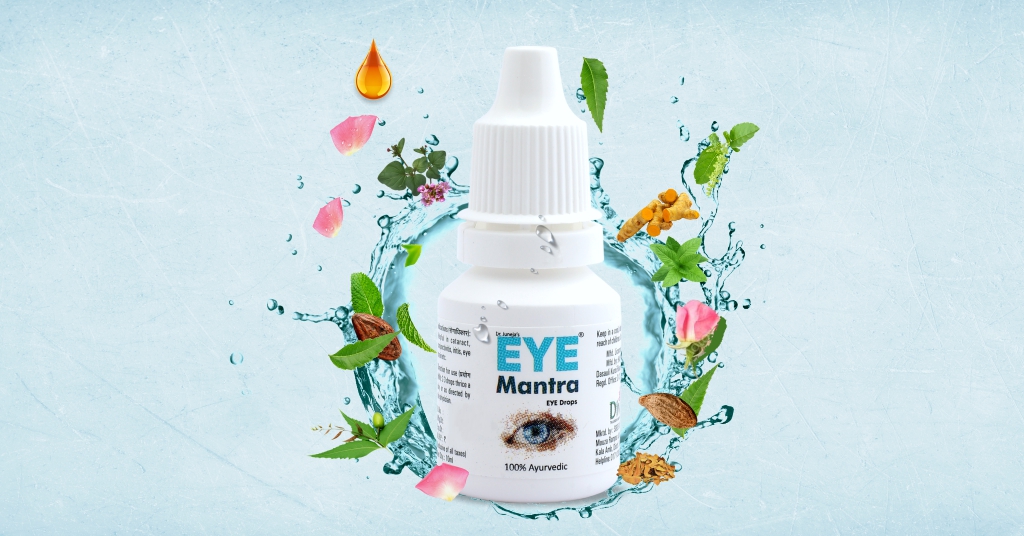Enriched with the goodness of Ayurvedic herbs, Eye Mantra Ayurvedic Drops are providing the necessary and much-awaited comfort to our eyes. It is this very fact that makes it a perfect fit for daily usage. Its extensive list of ingredients includes: Honey, Rose, Punarnava, Daruhaldi, Neem, Turmeric and Tulsi. Let’s read more to know what makes these ingredients stand out in the eye care segment.
HONEY
If we go through all the previous investigations which have been carried out to understand the innumerable benefits associated with honey, then we can comfortably conclude that honey might be a good remedy for ocular wounds and it could also be used as a panacea for eye diseases.
Additionally, honey has an antibacterial effect and can be used to prevent corneal scarring caused by infection. One research has also observed that topically applied honey can considerably reduce inflammation and irritation in our eyes. It does so by killing the harmful bacteria that could be resulting in an eye infection.
ROSE WATER

Just like honey, even Rose water has anti-inflammatory properties, which abates the symptoms of inflammatory eye disorders like conjunctivitis (also known as pink eye). As per the biological records, this is the clear membrane that lines the eyelids and covers the white part of our eyeball.
Whether we have computer eyestrain, eye allergies, or another condition, rose water is a natural remedy that may leave its comforting mark. To further the cause, Rose water can also aid in preventing dry eyes and cleanse the eyes of dust, reducing the likelihood of developing the condition of conjunctivitis itself.
PUNARNAVA
With the advancement in the Research and Development sector, it was been substantiated that the juice from the leaves of Punarnava can be mixed with honey and applied to the eyes to manage chronic ophthalmia and cataract. Fresh juice from roots has also shown its charm in relieving the symptoms of night blindness and conjunctivitis.
The other eye ailments tackled by this herbal ingredient are corneal opacity, watering eyes, and itchy eyes. Punarnava, as an indigenous plant, has an interesting story linked with the word itself. “Punarnava” could be broken up as “Punar” which means “once again”, and “Nava” which means “new”, on the whole meaning “becoming new again”. No surprise that the kind of influence it exerts on our eyes is the same.
DARUHALDI
Daruharidra as a herb has a lot of excitement revolving around it. This wild shrub is found in altitudes of some 5000 feet and above, characteristically in the Himalayas and Nepal. When it comes to eye disorders, it offers compelling benefits.
If we delve deep into it, we will realise that a special extract of Daruharidra known as Rasaut is used where the Kashaya of Daruharidra is boiled along with goat milk until a solid mass is formed. This solid mass is thereafter made into Anjana paste and applied to the eye. Due to its hot and bitter potency, it profuse watering which there onwards helps to clear out dust from the eyes.
NEEM
Through the years, we have grown accustomed to listening to the herbal benefits that neem brings to our lives EVERY DAY. There is barely any domain left untouched by neem. According to Ayurveda as well, it works like a wonder when it comes to enhancing the vision.
As a traditional mode of treatment, our ancestors used to chew the neem leaves to prevent the eyes from different diseases. Even in regards to eye irritation or redness, people have reported feeling better with the usage of neem water.
TULSI
Tulsi or Tulsi ma (as a major share of Indians calls it) has never ceased to extend its warmth and care to us. Literally speaking, its maternal touch subsides any stress of the day.
So, when people develop eye-related problems, Tulsi comes to their rescue and acts as an immediate cure by soothing the eyes. Tulsi leaves which are left in boiled water overnight can also be used to wash the eyes, to abate the stress related to dry eyes. It is astonishing to note that the cases of dry eyes are skyrocketing every day. In such a grim situation, Tulsi acts as a beacon of hope to subside the discomfort experienced by our dry eyes.
TURMERIC
Here comes the show-stopper now. The examinations have brought to the fore that administering curcumin – the bioactive compound of turmeric – directly to the back of the eye, using eye drops, may reduce the loss of retinal cells, which has been identified to be an early sign of the eye condition popularly known as glaucoma.
So, why should you opt for EYE MANTRA?

They are easy on the eyes and on your budget as well. Moreover, it is not rocket science for us to comprehend that we don’t need to be an eye doctor to understand the importance of keeping our eyes healthy.
But as age and other issues distress our vision, it’s difficult to know where to turn for answers. The beauty of the Eye Mantra blogs is that you shall always be abreast with the information that you are after. When it comes to eye health, the Eye Mantra Eye drop can be the right choice for the natural care of your eyes.

